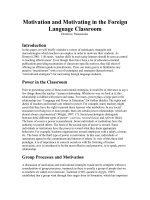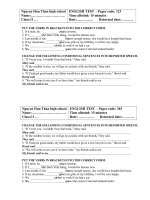- Trang chủ >>
- THPT Quốc Gia >>
- Hóa
Energy and matter in living things
Bạn đang xem bản rút gọn của tài liệu. Xem và tải ngay bản đầy đủ của tài liệu tại đây (3.26 MB, 10 trang )
Life Sciences
Standards
Preview
2.c. Students know decomposers,
including many fungi, insects, and
microorganisms, recycle matter from
dead plants and animals.
Standard Set 2. Life Sciences
2. All organisms need energy and
matter to live and grow. As a basis for
understanding this concept:
Standard Set 3. Life Sciences
2.a. Students know plants are the
primary source of matter and energy
entering most food chains.
3. Living organisms depend on one
another and on their environment for
survival. As a basis for understanding
this concept:
2.b. Students know producers and
consumers (herbivores, carnivores,
omnivores, and decomposers) are
related in food chains and food webs
and may compete with each other for
resources in an ecosystem.
Genre
Nonfiction
3.d. Students know that most
microorganisms do not cause disease
and that many are beneficial.
Comprehension Skill
Follow Instructions
Text Features
•
•
•
•
Captions
Diagrams
Labels
Glossary
Science Content
The Roles of
Living Things
Scott Foresman Science 4.3
ISBN 0-328-23547-4
ì<(sk$m)=cdfehg< +^-Ä-U-Ä-U
by Susan Turner
Vocabulary
carnivore
consumer
decomposer
ecosystem
food chain
food web
herbivore
microorganism
omnivore
producer
Picture Credits
Every effort has been made to secure permission and provide appropriate credit for photographic material. The
publisher deeply regrets any omission and pledges to correct errors called to its attention in subsequent editions.
Unless otherwise acknowledged, all photographs are the copyright of Dorling Kindersley, a division of Pearson.
Photo locators denoted as follows: Top (T), Center (C), Bottom (B), Left (L), Right (R), Background (Bkgd).
Opener: (Bkgd) ©Ed Reschke/Peter Arnold, Inc., (C) ©Roland Birke/Peter Arnold, Inc.; 2 (B) ©David Muench/Corbis;
3 Anup Shah/Natural Picture Library, Ltd.; 4 ©Raymond Gehman/Corbis; 5 (TL) Michael Fogden/Animals Animals/Earth
Scenes, (TR) Bruce Davidson/Natural Picture Library, Ltd., (C) Digital Vision, (BL) John Foxx, (BR) Jeanne Drake/Getty
Images; 6 (Bkgd) Ted Mead/Photo Library, (Inset) Peter Oxford/Nature Picture Library; 7 Tui De Roy/Minden Pictures;
8 (B) ©David Muench/Corbis; 9 (BR) Pete Oxford/Minden Pictures; 11 (L) Eye of Science/Photo Researchers, Inc., (R)
Photo Researchers, Inc.; 12 (TR) ©Roland Birke/Peter Arnold, Inc.; 13 Photo Researchers, Inc.; 15 (BL) Photo Researchers,
Inc., (T) Lynn M. Stone/Nature Picture Library, (BR) Brand X Pictures.
ISBN: 0-328-23547-4
Copyright © Pearson Education, Inc. All Rights Reserved. Printed in the United States of America.
This publication is protected by Copyright, and permission should be obtained from the publisher prior to any
prohibited reproduction, storage in a retrieval system, or transmission in any form by any means, electronic,
mechanical, photocopying, recording, or likewise. For information regarding permission(s), write to
Permissions Department, Scott Foresman, 1900 East Lake Avenue, Glenview, Illinois 60025.
1 2 3 4 5 6 7 8 9 10 V010 13 12 11 10 09 08 07 06
by Susan Turner
The Flow of Energy
The tropical rain forest is one kind of ecosystem.
An ecosystem is all the living and nonliving things in
an environment and the many ways they interact. An
ecosystem’s living things need energy, water, nutrients,
growing space, and the right temperatures.
The main source of energy in ecosystems is sunlight.
Photosynthesis in plants starts the flow of energy from one
living thing to another. Green plants use energy from sunlight
to change carbon dioxide and water into food and oxygen.
Plants use the energy that they make to grow and live.
Because plants are able to make their own food, they are
called producers.
Energy Flowing
Through Living Things
Unlike plants, animals cannot get energy by making their
own food. This makes them consumers. Consumers are
living things that eat other living things as food. Animals use
the energy they get from eating to live and grow. Some of the
energy they get from eating gets stored in their bodies.
Herbivores, carnivores, and omnivores are consumers.
Animals that eat only plants are herbivores. Tropical rain
forest gorillas are herbivores. They eat stems and leaves.
This chimpanzee is eating berries.
Chimpanzees and gorillas are closely
related, but chimpanzees also eat meat.
Many green plants live in
tropical rain forest ecosystems.
2
3
Animals that eat other animals are carnivores. The
Bengal tiger is a carnivore of the tropical rain forest. It eats
boars, wild oxen, and monkeys. When animals eat other
animals, the energy stored in the one animal’s body gets
transferred to the other animal. When a Bengal tiger eats a
boar, it gets the boar’s stored energy.
Animals that eat both plants and other animals are
omnivores. Tropical rain forest orangutans are omnivores.
They eat leaves, fruits, insects, and birds.
When plants and animals die or leave wastes, some
insects, fungi, and bacteria break the material down and use it
as energy. Organisms that break down plant and animal waste
and remains are decomposers. A mushroom is one type of
decomposer. It is a fungus that breaks down the remains of
dead trees and returns their nutrients to the soil.
Tropical Rain Forest Ecosystem
herbivores
Gorillas
Tree sloth
omnivore
Brown fungi, called conk, are
breaking down this tree’s bark.
Fungi are decomposers.
Orangutan
Tiger
Jaguar
carnivores
4
5
The Flow of Matter
Food Chain Links
Strangler fig trees live in tropical rain forests. They have
a huge amount of biomass, or mass of living matter. An
ecosystem’s living things depend on plant biomass.
Plants get energy from the Sun. They take in carbon,
nitrogen, and hydrogen from the soil, air, and water to make
their living parts. A plant’s energy and matter get passed on to
an animal when it eats the plant.
Organisms transfer energy by eating and being eaten in
a food chain. A tropical rain forest food chain starts with
strangler figs and other plants. These plants make energy
from sunlight. Howler monkeys and other herbivores get that
energy by eating plants. Harpy eagles and other carnivores get
energy from eating howler monkeys and other herbivores.
Producers are the first links in food chains. In the tropical
rain forest, and almost all other ecosystems, the producers are
plants. Producers include trees, vines, and flowering plants.
Parrots are herbivores. They eat the tropical rain forest’s
green plants or tree leaves. This makes parrots first or primary
consumers in the food chain. They gain energy from the
green leaves that they have eaten.
Animals that hunt other animals for food are called
predators. The harpy eagle is a predator of parrots. The hunted
animals, in this case parrots, are called prey. The harpy eagle
gets its energy from eating parrots and other prey.
Food chains may have many levels of consumers. The
harpy eagle has few predators. It is at the top of the tropical
rain forest’s food chain.
Parrots and other herbivores
are primary consumers.
Predators such as the harpy eagle prey
on parrots and other primary consumers.
6
7
Food Chains into Food Webs
Ways Food Webs Change
In most ecosystems, there are many different
interconnected food chains. In a tropical rain forest, for
example, a sloth eats more than one type of food. It can eat
leaves, fruit, and small animals. It also has to watch out for
more than one predator. Harpy eagles and pumas prey on
sloths. The sloth has to be smart in order to survive.
Sloths, harpy eagles, and pumas belong to the tropical
rain forest’s food web. A food web is a system of overlapping
food chains. The flow of energy and matter can travel in many
directions in a food web.
Look at the picture of the food web. What would happen
if the population of harpy eagles dropped? Look to see which
animals are connected to harpy eagles. With fewer harpy
eagles, more sloths would be able to survive.
If the sloth population were to increase, more food would
be available for the pumas. The puma population could
increase. But the extra sloths would eat more fruit. This would
mean less food for the palm civets. Their numbers would start
to decrease. If the palm civet population were to decrease,
how would that affect their predators?
All living things are connected to each other. If one part of
the food web changes, it can affect the entire ecosystem.
Here you see one possible food
web in a tropical rain forest.
The Sun
Palm civet
Puma
Fern plants
Tree sloth
8
Harpy eagle
9
Decomposers
Microorganisms and Decay
Without decomposers, the producers in an ecosystem
would use up all of the nutrients in the soil. This would
greatly affect the ecosystem. If decomposers were not
constantly returning nutrients to the soil, new plants could
not grow. This would cause the herbivores to die off, since
they would have no food. Without herbivores, the carnivores
would no longer be able to survive, because their food supply
would be gone.
Decomposers break down wastes, along with materials
from dead plants and animals. They use these materials’
stored food energy to grow, reproduce, and stay alive. The
breaking down of wastes releases nutrients back into the soil,
allowing the cycle to start again.
Have you ever seen an apple with a brown spot on it? If
you looked at the apple later, the brown spot would be larger.
Decomposers cause these spots as they break down the apple.
Some decomposers, such as some insects and fungi,
are big enough to be seen. But many are microorganisms.
A microorganism is a living thing that is too small to
see without a microscope. Bacteria and some fungi are
microorganisms.
Decay is very important to the life of an ecosystem. When
decay occurs, nutrients are recycled into the soil and water.
This allows new plants to grow and supply the ecosystem
with energy. When a leaf falls from a tree in a tropical rain
forest, the forest’s decomposers get to work digesting it. This
makes the leaf ’s nutrients available for new plant growth.
Decomposers return nutrients
to the soil when they break
down wastes and remains.
These yeast cells and molds are
growing on a rotten apple. Yeast cells
and molds are microorganisms.
10
11
The Role Of
Microorganisms
You cannot see them without a microscope, but
microorganisms are all around us. There are many more
microorganisms on Earth than there are plants and animals.
Most microorganisms are not harmful. Many of them keep
living things alive by carrying out certain roles.
One type of microorganism is a protist. Many protists
are one-celled organisms. Some protists, such as algae, are
producers. They make their own food much as plants do.
Protists such as these are the primary producers in the food
webs found in most waters on Earth! Other protists found in
the water keep it clean by eating other microorganisms.
Protists such as algae (right) are producers.
The large green circles (below) are lily pads.
12
Microorganisms That Help Us
Some helpful microorganisms are found in your digestive
system. Bacteria in your intestines not only help digest food,
but also help to eliminate some types of harmful bacteria.
Helpful bacteria are found in certain dairy foods such as
yogurt, sour cream, buttermilk, and cheese.
Another helpful microorganism is a mold called
Penicillium. You may have seen some of this mold growing
on a rotting orange. In 1928, a Scottish scientist named
Alexander Fleming discovered that this microorganism
produces an antibiotic. An antibiotic is a substance that kills
disease-causing bacteria. Antibiotics such as those based on
Penicillium have been used to fight harmful bacteria.
The green spots on this bread are Penicillium
mold. Alexander Fleming’s work with Penicillium
led to a major discovery in antibiotics.
13
Microorganisms in Soil
Microorganisms are everywhere in the soil. A one-liter jar
filled with fertile soil will contain as many as 1 trillion bacteria
and 10 to 100 million protists!
Some bacteria found in soil produce natural fertilizer
for plants. These bacteria take the element nitrogen and
turn it into a compound that plants can use. Plants use this
compound to produce proteins that they need to live and
grow.
You can see the spider and earthworm
without using a microscope. You need a
microscope to see the soil’s microorganisms.
14
Microorganisms
Under the Microscope
The water in a tropical rain forest contains
microorganisms such as flagellates (flah-JEL-ates),
plasmodium (PLAZ-moh-DEE-um) and thallasiosira
(THALL-ah-cee-oh-SEER-ah). If you filled an eyedropper
with rain forest water and observed it over several weeks,
the living things inside the eyedropper would change. Each
couple of weeks, certain microorganism populations would
grow larger, while others would die off.
Plasmodium (bottom left) can be seen through
a microscope. Plasmodium live in wet, tropical
environments. They are carried by mosquitoes.
15
Glossary
What did you learn?
1. What is the main source of energy in most ecosystems?
carnivore
an animal that eats other animals
2. How do nutrients get returned to the soil?
consumer
a living thing that eats other living things
for food
3. How are herbivores and carnivores different?
decomposer
an organism that breaks down wastes and
remains of other organisms
ecosystem
the living and nonliving things and the
ways they interact in an environment
food chain
the transfer of energy and matter from one
living thing to another by eating and being
eaten
food web
a system of overlapping food chains in
which energy and matter flow through
many branches
herbivore
an animal that eat plants
microorganism a living thing too small to be seen without
a microscope
omnivore
an animal that eats both plants and
animals
producer
a living thing that makes its own food
16
4.
Use an encyclopedia, dictionary,
thesaurus, or other information from the library-media
center to write about decomposers in an ecosystem other
than the tropical rain forest.
5.
Follow Instructions Write instructions that another
student can follow to show a food chain in an ecosystem
other than the tropical rain forest.









